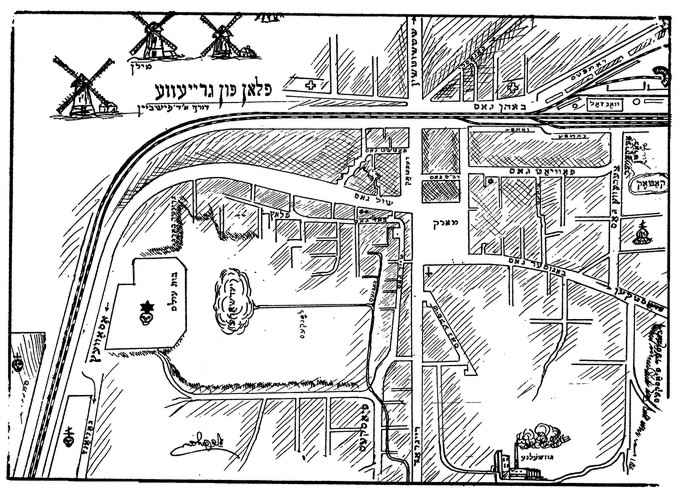 |
Map of Grajewo
|
|
[Page 7]
Translated by Tina Lunson
With sorrowful hearts and mournful spirits we stand by the unveiling of this modest memorial for the sanctified and martyred, our murdered fathers and mothers, sisters and brothers, comrades and friends from our old hometown, Grayeve [Grajewo].
Only a few Grayeve Jews were saved from the Nazi murderers, only a few remained alive to tell of the destruction. In Grayeve, as in hundreds of other towns and villages in Poland, there is no longer one Jew. Consequently, it took several years after Hitler's devastating inundation until we felt the courage and gathered the strength to erect this memorial – a Grayever Yizker-Bukh. [Grayeve Memorial Book]
A town with a Jewish community of several thousand souls, Grayeve in the last decades of her life demonstrated response to, and absorption in the social, cultural and political currents and ambitions of the large creative Jewish settlement in Poland. Little Grayeve also published a number of distinguished Yiddish and Hebrew writers, scholars and community leaders, of whom a significant number, along with other sons of the town, in time emigrated to America, Erets Yisroel and other lands. The Grayeve Yizker-Bukh was entirely written with our own energies and is presented as both a monograph of our annihilated community and a certain reflection of the life of the Grayeve landslayt [countrymen] in America and Israel.
Of course, in most of the treatises of the book one hears the wail of mourners: in the memoirs, the tone of funeral oratory and eulogy, and there is necessarily lament in the descriptions of the Holocaust. For the writers and publishers of this book, the Khurbm [destruction] Grayeve, like the overall tragedy of the Jews in Europe, is bound up with personal tragedy, with sorrow for their families and close ones.
There are also here and there repetitions in descriptions about the same matters, events and persons. But the repetition completes the description and all together they create a picture of its bonds and ways of life, its needs, ambitions and struggles, its joys and sorrows, disappointments and achievements. Together, everything relates how much we have lost, the inestimable loss!
There are also in this book descriptions and documents of the Jewish Khurbm in the neighboring towns around Grayeve – Shtshutshin [Szczuczyn], Radzshilov [Radzilow], Kolne [Kolno] and others, the towns that always partnered with Grayeve and enjoyed its society and culture. May the landslayt from the annihilated Jewish towns, like the surviving remnant wherever they are found, consider the Grayever Yizker-Bukh as a memorial to their most loved and dearest, both for those mentioned in the book and for those not mentioned.
We extend a warm hand and a yasher-keyekh [may your strength grow] to all the landslayt who sent in materials for the Yizker-Bukh. At the same time we beg the pardon of our dear landslayt whose articles could not, for technical reasons be included in the book.
We are especially grateful to our hometown poet Nakhman Rapp, one of the small number of Grayeve Jews who remained in Poland and who sensed the difficult and painful mission to investigate and describe just a small part of the destruction of Grayeve. The poet himself lost his closest friends in Grayeve, and by a miracle survived in the Soviet Union. After the bloody, devastating Nazi inundation he went back to Poland, but in his hometown he found no living Jewish soul (or even any dead ones), as he relates in his history of the Grayeve ghetto and as he eulogized it in his book of poems Funken in ash [Sparks in the Ashes], published in Wroclaw in 1947. The description by Rapp, which we print in this book, is certainly an important addition to the history of the Jewish Khurbm and martyrdom under the Nazis, as are also the documents from the Jewish Historical Committee in Bialystok, which we print here. For the English-reading children and relatives of our landslayt, we print a shortened overview of N. Rapp's description and also an introduction to the book by Dr. G. Gorin.
With bowed heads and wringing hands we stand at this modest memorial for our slaughtered Grayeve community. Khaval al d'avdin v'la mishtak'khin. [A pity for our loss of those who are no longer with us]. May this Yizker-Bukh be a lasting reminder for the landslayt of Grayeve and vicinity to unite their strengths through the Grayeve Aid Committee and other organizations that help to build and strengthen Jewish community life. May this Grayever Yizker-Bukh be a reminder from generation to generation that the survival of the Jewish people is eternally inseparable from the ideals: “end of days,” social heritage, peoples' freedom and world peace.
Editorial colleagues of the United Grayeve Aid Committee
Dr. G. Gorin, Chairman
Hayman Blum
Sh. Y. Fishbeyn
New York, April 15, 1950
[Page 8]
|
|
Map of Grajewo |
|
|
JewishGen, Inc. makes no representations regarding the accuracy of
the translation. The reader may wish to refer to the original material
for verification.
JewishGen is not responsible for inaccuracies or omissions in the original work and cannot rewrite or edit the text to correct inaccuracies and/or omissions.
Our mission is to produce a translation of the original work and we cannot verify the accuracy of statements or alter facts cited.
 Grajewo, Poland
Grajewo, Poland
 Yizkor Book Project
Yizkor Book Project
 JewishGen Home Page
JewishGen Home Page
Copyright © 1999-2024 by JewishGen, Inc.
Updated 15 Mar 2014 by LA